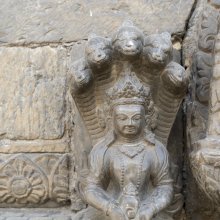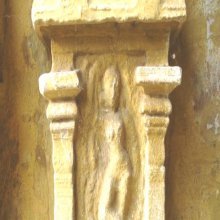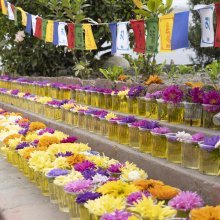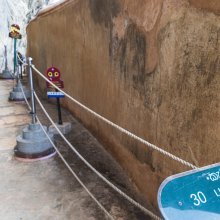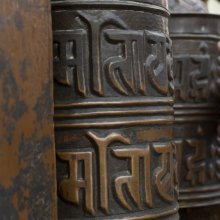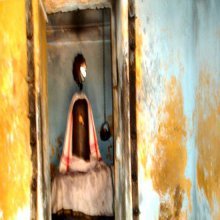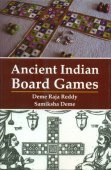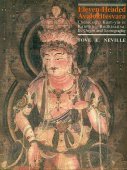Wall: 4 definitions
Introduction:
Wall means something in Hinduism, Sanskrit, the history of ancient India, biology. If you want to know the exact meaning, history, etymology or English translation of this term then check out the descriptions on this page. Add your comment or reference to a book if you want to contribute to this summary article.
Images (photo gallery)
(+156 more images available)
In Hinduism
Vastushastra (architecture)
Source: Shodhganga: Elements of Art and Architecture in the Trtiyakhanda of the Visnudharmottarapurana (vastu)Walls in ancient Indian were commonly built using Bricks as the primary Material, which was also used for the Construction of Temples, according to the Viṣṇudharmottarapurāṇa, an ancient Sanskrit text which (being encyclopedic in nature) deals with a variety of cultural topics such as arts, architecture, music, grammar and astronomy.—Brick (in Sanskrit: iṣṭakā) is one of the most important materials in the construction of a temple as it still bears the similar importance even in the modern era. It is a building material which is used to make walls. In ancient time bricks used to be made of clay which were of four kinds, ūṣara, pāṇḍura, kṛṣṇacikkaṇa and tāmraputtaka. According to the Mayamata, tāmraputtaka type of clay is the best one for making of bricks.

Vastushastra (वास्तुशास्त्र, vāstuśāstra) refers to the ancient Indian science (shastra) of architecture (vastu), dealing with topics such architecture, sculpture, town-building, fort building and various other constructions. Vastu also deals with the philosophy of the architectural relation with the cosmic universe.
Shilpashastra (iconography)
Source: Shodhganga: Elements of Art and Architecture in the Trtiyakhanda of the Visnudharmottarapurana (shilpa)A (Plastered) Wall was commonly used as a Canvas in the ancient Indian art of Painting (citra), and can be denoted by the Sanskrit terms Kuḍya or Bhitta.—Canvas is a kind of surface on which a painter can draw a picture. In ancient time walls are seen to be plastered with different substances and these were prepared for Painting. The plastered wall which was used as canvas is known as kuḍya or bhitti. The process of preparing those walls for Painting was called as kuḍyanirmāṇa or bhittinirmāṇa. it is suggested that before going to start Painting on walls one should plaster a wall. For the process of kuḍya i.e., plastering on a wall, the painter needs iṣṭakācūrṇa i.e., powder of bricks and mṛd i.e., clay as basic ingredients. [...] The Viṣṇudharmottarapurāṇa advices that after plastering the wall, the painter should proceed to start the Painting work.

Shilpashastra (शिल्पशास्त्र, śilpaśāstra) represents the ancient Indian science (shastra) of creative arts (shilpa) such as sculpture, iconography and painting. Closely related to Vastushastra (architecture), they often share the same literature.
India history and geography
Source: Singhi Jain Series: Ratnaprabha-suri’s Kuvalayamala-katha (history)Walls (of the houses) in ancient Indian cities were beautified, as part of celebrations of the “grand festival” (Mahotsava) of the coronation of a crown prince (yuvarāja-abhiṣeka), as depicted in the Kathās (narrative poems) such as Uddyotanasūri in his 8th-century Kuvalayamālā (a Prakrit Campū, similar to Kāvya poetry).—Page 199: Here is described yuvarāja-abhiṣeka-mahotsava when the city of Ayodhyā put on gala appearance by means of beautifying streets, [...] making offerings on the cross roads, beginning dramatic performances, hoisting of the lion banners, installing canopies, cloth pieces were being torn in proper pieces pālī for being wrapped round the post, pendants like the Kaṭisūtra ornaments were hung from the ceilings of doorways and walls of the houses, the great jewels were being taken out and put on show in the treasury [...]”.

The history of India traces the identification of countries, villages, towns and other regions of India, as well as mythology, zoology, royal dynasties, rulers, tribes, local festivities and traditions and regional languages. Ancient India enjoyed religious freedom and encourages the path of Dharma, a concept common to Buddhism, Hinduism, and Jainism.
Biology (plants and animals)
Source: Google Books: CRC World Dictionary (Regional names)Wall in India is the name of a plant defined with Lablab purpureus in various botanical sources. This page contains potential references in Ayurveda, modern medicine, and other folk traditions or local practices It has the synonym Vigna aristata Piper (among others).
Example references for further research on medicinal uses or toxicity (see latin names for full list):
· Contributions from the United States National Herbarium (1926)
· Willdenowia (1986)
· Kew Bulletin (1970)
· Journal of Cytology and Genetics (1990)
· Recent Res. Pl. Sci. (1979)
· Species Plantarum (1753)
If you are looking for specific details regarding Wall, for example side effects, pregnancy safety, chemical composition, extract dosage, diet and recipes, health benefits, have a look at these references.

This sections includes definitions from the five kingdoms of living things: Animals, Plants, Fungi, Protists and Monera. It will include both the official binomial nomenclature (scientific names usually in Latin) as well as regional spellings and variants.
See also (Relevant definitions)
Starts with (+3): Wall fern, Wall germander, Wall painting, Wall spleenwort, Wall-rue, Wall-rue spleenwort, Wallagdoora, Wallaiki, Wallakotu, Wallasige, Wallflower mustard, Wallia-pal-valli, Wallich eriophyton, Wallich palm, Wallich strophanthus, Wallichia densiflora, Wallichia disticha, Wallichia nana, Wallimale, Wallimung.
Query error!
Full-text (+5828): Bhitti, Kudya, Prakara, Nagadanta, Bhittika, Aveshtaka, Prantadurga, Pracira, Prakariya, Mandodaka, Shala, Bhittipada, Avapothika, Kudyacchedya, Adipana, Torana, Atarpana, Bhumibandha, Bhintada, Paligha.
Relevant text
Search found 370 books and stories containing Wall, Walls, The wall; (plurals include: Walls, Wallses, The walls). You can also click to the full overview containing English textual excerpts. Below are direct links for the most relevant articles:
Writing on The Wall < [October – December, 2000]
Entering Venice < [September-October 1931]
Fresco-Painting in ‘Sivatatvaratnakara’ < [July-August 1932]
Parables of Rama (by Swami Rama Tirtha)
Story 82 - How to Acquire All Knowledge < [Chapter XI - Mind]
Story 84 - Two ways of Acquiring Knowledge < [Chapter XI - Mind]
Story 221 - The King and two painters < [Chapter XLI - Purity]
The Structural Temples of Gujarat (by Kantilal F. Sompura)
Chapter 12 - The architectural treatment of the Mandovara < [Part 2, Section 3: The Architectural Canons]
Chapter 5 - The Ground plan of the Garbhagriha < [Part 2, Section 3: The Architectural Canons]
1.7. The Kakshasana or Candravalokana < [Chapter 14 - The vertical parts of the Mandapa]
Vernacular architecture of Assam (by Nabajit Deka)
Architecture and Technique of Barn < [Chapter 5]
Pajaghar Typology (b): Wall Construction < [Chapter 5]
Pajaghar Typology (d): Door, Window and Ventilators < [Chapter 5]
Bhagavati-sutra (Viyaha-pannatti) (by K. C. Lalwani)
Part 2 - What is it that is burning in a lamp < [Chapter 6]
Part 10 - Criteria for purity < [Chapter 1]
Part 21 - On the course of life of the non-restrained < [Chapter 1]
Arts in the Puranas (study) (by Meena Devadatta Jeste)
9. Mandapas (halls, porches) < [Chapter 3 - Architecture in the Puranas]
8. Temple Architecture < [Chapter 3 - Architecture in the Puranas]
6. The preparation of the Wall-plaster < [Chapter 5 - Painting in the Puranas]
Related products
